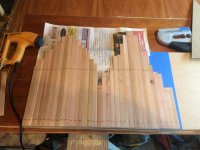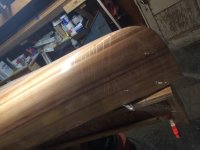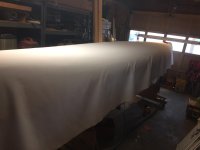Thanks Jim, I'm feeling pretty good about it! I'm excited to get it sanded and use it as a mold for the Kevlar copy.
Does anyone have tips or suggestions they would be willing to share about working with Kevlar cloth?
I'm pretty sure I don't want to be trying to wet out multiple layers at a time considering the difference in absorption between glass and Kevlar.
I have 4 oz as well as 8 oz in 60" widths which I got a crazy good deal on. 10$ per lineal yard.
I was thinking 2 full layers of 4 oz with a partial of 8 oz.
Or two full layers of 8 oz maybe...
With either layup I will also put a full layer of 6 oz glass for sanding purposes on the outside.
I was poking around the net yesterday and found something called aramid honeycomb which can be used as a core and seems to be very lightweight. Is anyone familiar with this material?
Does anyone have tips or suggestions they would be willing to share about working with Kevlar cloth?
I'm pretty sure I don't want to be trying to wet out multiple layers at a time considering the difference in absorption between glass and Kevlar.
I have 4 oz as well as 8 oz in 60" widths which I got a crazy good deal on. 10$ per lineal yard.
I was thinking 2 full layers of 4 oz with a partial of 8 oz.
Or two full layers of 8 oz maybe...
With either layup I will also put a full layer of 6 oz glass for sanding purposes on the outside.
I was poking around the net yesterday and found something called aramid honeycomb which can be used as a core and seems to be very lightweight. Is anyone familiar with this material?

















